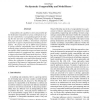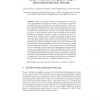270 search results - page 23 / 54 » Hierarchical Model to Develop Component-Based Systems |
APSEC
2007
IEEE
13 years 11 months ago
2007
IEEE
It is difficult to adopt a simulation technology for simulating a software process because of the difficulty in developing a simulation model. In order to resolve the difficulty, ...
ASIAMS
2007
IEEE
14 years 2 months ago
2007
IEEE
Composability, the capability to select and assemble offthe-shelf model components in various combinations to satisfy user requirements, is an appealing approach in reducing the t...
AUSAI
2006
Springer
13 years 11 months ago
2006
Springer
There is increasing evidence to suggest that the neocortex of the mammalian brain does not consist of a collection of specialised and dedicated cortical architectures, but instead ...
DAC
2011
ACM
12 years 7 months ago
2011
ACM
SystemC is a popular modeling language which can be used to specify systems at bstraction level. Currently, SystemC tools can not cope with SystemC models for which the module hie...
ASE
2006
13 years 7 months ago
2006
: UML statecharts are used for describing dynamic aspects of system behavior. The work presented here extends a general Petri net-based methodology to support formal modeling of UM...


